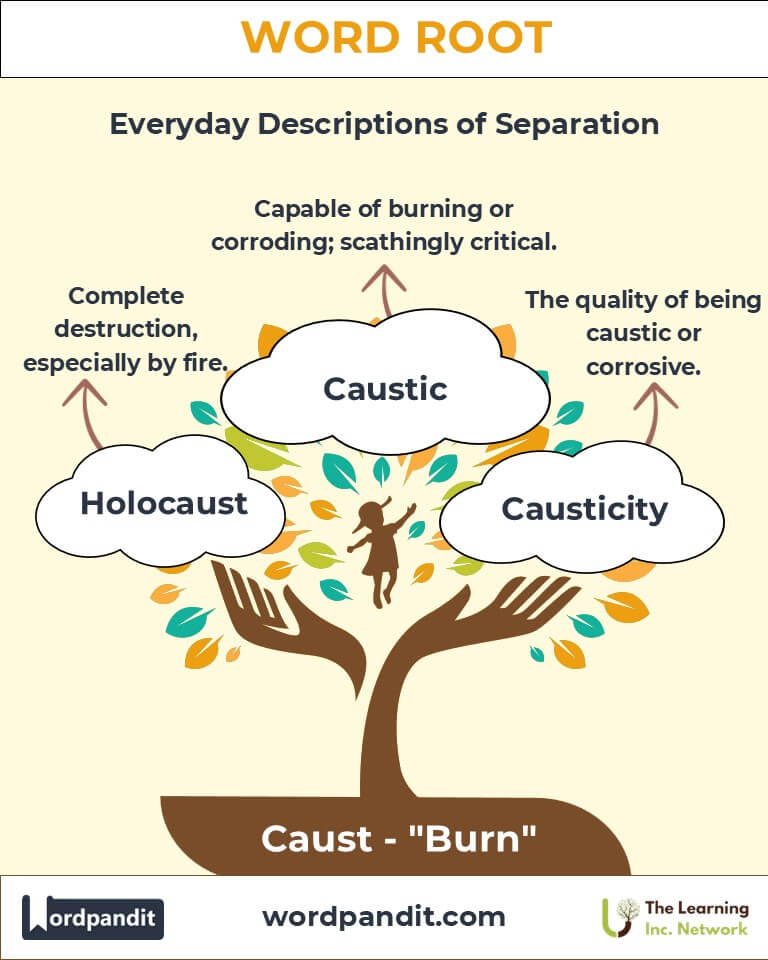Caust: The Burning Heart of Language and Expression
Explore the fiery essence of the root "caust," derived from the Greek word kaustos, meaning "burnt." From scathing remarks to historical devastations, "caust" fuels a vocabulary that expresses intensity, destruction, and transformation. Discover how this root ignites our language and shapes its meaning across disciplines.

Table of Contents
- Introduction: The Essence of "Caust"
- Etymology and Historical Journey
- Mnemonic: Unlocking the Power of "Caust"
- Common "Caust"-Related Terms
- "Caust" Through Time
- "Caust" in Specialized Fields
- Illustrative Story: "Caust" in Action
- Cultural Significance of the "Caust" Root
- The "Caust" Family Tree
- FAQs about the Caust Word Root
- Test Your Knowledge: Caust Mastery Quiz
- Conclusion: The Enduring Legacy of "Caust"
Introduction: The Essence of "Caust"
What do a searing critique and a devastating fire have in common? Both burn in their intensity, an idea captured by the root "caust." Pronounced as kost, this linguistic root originates from the Greek kaustos, meaning "burnt." It vividly conveys the concepts of heat, destruction, and fiery transformation. From everyday expressions to specialized fields like chemistry, "caust" fuels a vocabulary rich in energy and impact.
Etymology and Historical Journey
The root "caust" traces its fiery path back to the Greek kaustos (burnt) and kaiein (to burn). Latin adopted it as caustus, preserving its destructive yet transformative essence. During the Middle Ages, it entered Old French and later English, appearing in words like "caustic." Over centuries, the root retained its scorching symbolism, becoming a staple in both literal and metaphorical contexts.
Mnemonic: Unlocking the Power of "Caust"
To remember "caust," picture a firebrand, its glowing ember spelling out the letters C-A-U-S-T, illuminating the power of heat and destruction.
Mnemonic Device: "CAUST ignites with burning brilliance, leaving a lasting impression—literal or metaphorical."
Common "Caust"-Related Terms
- Caustic (kaw-stik)
- Definition: Capable of burning or corroding; scathingly critical.
- Example: "Her caustic remarks left the audience stunned."
- Holocaust (hol-oh-kawst)
- Definition: Complete destruction, especially by fire; historically refers to the genocide during World War II.
- Example: "The forest fire was a holocaust that destroyed thousands of acres."
- Causticity (kaw-stis-i-tee)
- Definition: The quality of being caustic or corrosive.
- Example: "The causticity of the chemical required careful handling."
- Encaustic (en-kaw-stik)
- Definition: A method of painting using heated, pigmented wax.
- Example: "The artist created encaustic masterpieces that glowed with vibrant colors."
- Cauterize (kaw-tuh-rahyz)
- Definition: To burn tissue to prevent infection or stop bleeding.
- Example: "The doctor had to cauterize the wound to save the patient."
"Caust" Through Time
- Holocaust: Originally signifying "sacrifice by fire," the term evolved into a metaphor for catastrophic destruction and later, the historical atrocity of genocide during World War II.
- Encaustic: This ancient art form thrived in Greco-Roman cultures and has seen a resurgence in modern times as a sophisticated painting technique.
"Caust" in Specialized Fields
- Chemistry
- Term: Caustic Soda (Sodium Hydroxide)
- Application: A powerful alkaline compound used in cleaning and manufacturing.
- Medicine
- Term: Cauterization
- Application: The practice of using heat to treat wounds or stop bleeding.
- Art
- Term: Encaustic Painting
- Application: A method of art-making that blends pigments with hot wax for vibrant, textured effects.
Illustrative Story: "Caust" in Action
Maya, a young artist, was captivated by the luminous beauty of encaustic painting. In her first project, she depicted a fiery sunset, layering molten wax in rich, translucent hues. Meanwhile, her scientist friend Ravi was experimenting with caustic soda to develop an eco-friendly cleaning solution. Their conversations, blending art and science, demonstrated how "caust" burns brightly across disciplines, leaving a lasting impact on creativity and innovation.
Cultural Significance of the "Caust" Root
"Caust" embodies the dual nature of fire: its power to destroy and its potential to transform. From ancient rituals of purification by fire to the devastating Holocaust of the 20th century, this root captures humanity’s fascination with and fear of the flames. Its presence in art, science, and language underscores its enduring relevance.
The "Caust" Family Tree
- Root: Kaustos (Greek)
- Meaning: Burnt
- Example: Caustic
- Related Roots
- Ign (Latin: fire)
- Example: Ignite, ignition.
- Therm (Greek: heat)
- Example: Thermal, thermostat.
- Ign (Latin: fire)
- Prefix/Suffix Combinations
- En- (within): Encaustic
- -ize (to make): Cauterize
FAQs About the "Caud" Word Root
Q: What does "caud" mean?
A: "Caud" comes from the Latin word cauda, meaning "tail." It is used in anatomy, zoology, and biology to refer to structures or features associated with tails or posterior ends in living organisms.
Q: What is a caudal fin, and why is it important?
A: A caudal fin is the tail fin of a fish or aquatic vertebrate. It plays a crucial role in propulsion, steering, and maintaining stability while swimming. Without a functional caudal fin, a fish’s ability to move efficiently would be significantly impaired.
Q: What is the significance of the caudate nucleus in the brain?
A: The caudate nucleus is a tail-like structure in the brain that is part of the basal ganglia. It is involved in motor processes, learning, memory, and emotion regulation. Dysfunction in the caudate nucleus has been linked to neurological disorders such as Parkinson’s disease and Huntington’s disease.
Q: Which animals belong to the order Caudata, and what are their defining features?
A: Salamanders and newts belong to the order Caudata. They are characterized by their elongated bodies, tails that persist throughout life, and the ability to regenerate lost limbs and tails. This regenerative ability makes them a key focus in biological research.
Q: What does "caudal" mean in anatomy, and how is it used?
A: In anatomy, "caudal" refers to structures located toward the tail or posterior part of the body. In humans, it can also mean structures near the lower back or closer to the spinal end. It is often used in medical imaging and descriptions to provide precise location references.
Q: What is a caudectomy, and when is it performed?
A: A caudectomy is a surgical procedure to remove a tail or tail-like structure. It is commonly performed in veterinary medicine due to injury, infection, or aesthetic purposes (in some breeds). In humans, it may refer to the removal of tailbone-related growths or structures.
Q: What is the difference between "caudate" and "caudal"?
A: "Caudate" refers to having a tail or a tail-like structure, while "caudal" specifically describes the direction or location toward the tail or posterior end of the body. For example, a caudate nucleus has a tail-like shape, while caudal vertebrae refer to the tail-end vertebrae.
Test Your Knowledge: "Caud" Mastery Quiz
1. What does the root "caud" mean?
2. Which term refers to a tail-like brain structure?
3. What is a caudal fin used for?
4. What does "caudate" describe?
5. Which order of amphibians is characterized by tails?
Conclusion: The Enduring Legacy of "Caust"
The root "caust" serves as a reminder of fire’s dual nature: its ability to destroy and transform. From its literal applications in chemistry and medicine to its metaphorical use in language and art, "caust" continues to illuminate the human experience. Let its fiery essence inspire you to explore the power of words that burn brightly in meaning and impact.











